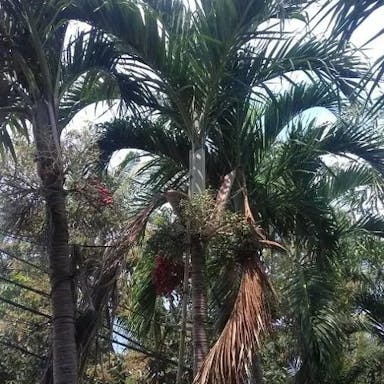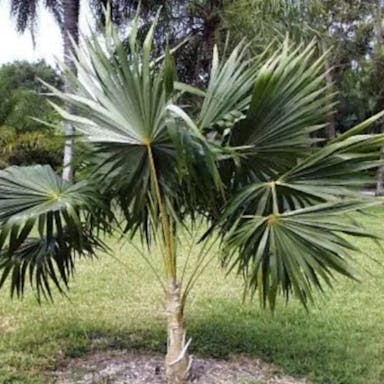Wild date palm is a species of flowering plant in the palm family Arecaceae. It is native to the subcontinent and is commonly found in tropical places. The plant has leaves that can grow up to 3 m in length, with leaflets arranged in a way. The flowers of Phoenix sylvestris are small and yellow, clustered on long, inflorescences. The fruit produced oval-shaped, green, turning orange when ripe, and is edible but not as sweet as the dates from the date palm. This plant is relatively easy to grow, a wide range of soil types and climates. Phoenix sylvestris is also known for its value, adding a tropical touch to places.
Wild date palm
- Scientific name
- Phoenix sylvestris
Basic Information
- Arecaceae Family Phoenix Genus Wild date palm Species
- Arecaceae > Phoenix > Phoenix sylvestris
- 83%
- The Completeness of This Encyclopedia
Please help us complete the encyclopedia, Terrarium is a encyclopedia service to be completed with everyone in the world. Currently, this page is 83% complete. For more information on how to contribute, please click here.
- Palmae
- Tree
- Height
- 10000cm ~ 15000cm
- Flower Color
- Leaf Color
- Anthesis
- spring
- Sunlight Exposure
Full Sun Long hours of sunlight from morning to afternoon Partial Shade A location in the shade of a tree or where either the morning or afternoon is shaded Full Shade A place where there is no direct sunlight
- Full Sun
- Hardiness Zones
This is an indicator to know to which zone each plant can winter. Knowing the zone of each plant gives you an idea of the cold temperature resistance when grown in the ground without a roof. 2: -42.7 to -40.0 3: -39.9 to -34.4 4: -34.3 to -28.9 5: -28.8 to -23.3 6: -23.2 to -17.8 7: -17.7 to -12.2 8: -12.1 to -6.7 9: -6.6 to -1.1 10: -1.0 to 4.4 11: 4.5 to 10.0
- 10
- Cold resistance
- Fair
- Heat resistance
- Excellent
- Habitat of origin
- India, Sri Lanka
- Growth Rate
- Slow
What is Wild date palm (Phoenix sylvestris)?
What is Wild date palm (Phoenix sylvestris)
Flower meaning
The flower symbolism frequently utilized in the United States for the Phoenix dactylifera, or date palm, includes: - Fortitude - Tenacity - Stamina A prime illustration of this is "Strength".
Calendar of Wild date palm (Phoenix sylvestris)
Calendar
Wild date palm in the United States typically blooms in late spring to early summer. The flowers are at their best during the month of May. Blooming occurs once a year, usually lasting for a few weeks. The period required for blooming can vary but generally takes around 2 to 3 weeks. To make the flowers bloom longer, ensure the plant receives adequate sunlight, water, and nutrients. Pruning dead or damaged fronds can also promote healthier blooming. Wild date palm requires adequate sunlight, water and nutrients for proper growth. The palm should be free from pests and diseases. Soil should be well drained. Pruning helps keep the palm healthy.
How to grow Wild date palm (Phoenix sylvestris)
Watering
The day desert palm requires watering on seven and ten days between. During fall season and winter, reducing water to between fourteen and twenty-one days. Guaranteeing well-drained soil prevents waterlogging, leading to decomposition. Thoroughly hydrate the plant, permitting excess to empty from container. Insert finger in soil up to five centimeters to check moisture level; if arid, it's time to water. Modify watering frequency based on conditions like ambient temperature and humidity.
Soil and Fertilizer
Wild date palm flourishes in drained sandy ground with a pH scope of 6.0 to 7.5. A balanced plant food with a proportion of 8-3-9 (N-P-K) applied three times per year in spring, summer, and fall. Spread fertilizer around the foundation of the plant, avoiding direct contact with the trunk. During the first year, apply 1 pound of plant food per plant, slowly expanding to 3 pounds per plant in the following years. Testing soil is suggested to screen supplement levels and change fertilizer applications accordingly.
Sunlight and Place
Wild date palm thrives in full sun exposure, requiring at least 6 hours of direct sunlight daily. Growth is excellent under high temperatures, suitable for hot areas. It withstands cold to around 20°F (-6°C) for a short time. In winter, young plants should be protected or brought inside. Ideal growing temperature is 70-100°F (21-38°C). Too cold causes frost damage, too hot causes sunburn. For good growth, place in a spot with drainage and sun. Don't overwater and allow air flow.
Advanced Information of Wild date palm (Phoenix sylvestris)
Pruning
Wild date palm needs occasional trimming and cutting back dead or ruined leaves, support healthy increase, and keep a pleasing look. Trimming is ideal in late winter or early spring before new leaves come out. To trim, utilize sharp, clean tools to cut leaves near the trunk without harming it. Take out any unwanted new shoots at the base. After trimming, give a slow-release fertilizer to encourage new leaves and water the plant thoroughly. Stay away from over-trimming, as it can stress the plant. Regular trimming helps stop disease and pest problems.
Planting and Harvest
Wild date palm is best growed in pots for easy grow and care. For planting in pot, take container with holes at bottom. Fill with soil that drains good. Put the palm in same deep as before. After planting, give water a lot. Put in sunny place. Put in little bigger pot every 2-3 years so it can grow more. Sometimes make leaves wet to keep wet. Don't give too much water so roots stay healthy.
Propagation
Wild date palm can be propagated through seeds, division, and offshoots. Separating the offshoots from the parent plant and planting them in individual containers is one technique. Offshoots should be carefully removed and planted in a suitable medium. Another method is taking parts from the stem or roots, helping them form roots, and putting them in a moist place. Leaves can also be used by letting them callus and planting them in a well-draining mixture.
Pests and Diseases
Wild date palm suffers from various insects and illnesses. One is the red palm weevil. It can seriously harm the palm by tunneling into the trunk. This insect feeds on the tissues of the plant. The pest can make the palm wilt and turn yellow. Finally it can kill the palm if not treated. Another issue is bayoud disease. This is caused by a fungus. It infects the roots and spreads in the plant. As a result, the leaves become yellow and wither. To prevent these problems, it is key to have good practices. Removing infected plant parts helps. Avoiding too much water also helps. Too much water makes good conditions for the pathogens to grow well. Also, checking the plant regularly for early signs is good. This allows quick action. Proper fertilizing is good too. It gives the plant the best growing conditions. This helps the plant defend itself from potential threats.
Habitat of Wild date palm (Phoenix sylvestris)
Habitat
Toxicity of Wild date palm (Phoenix sylvestris)
Health Benefits
- edible
- edible
- Toxic
- No toxicity
NO DATA
Toxic for dogs and cats
NO DATA
Q&A of Wild date palm (Phoenix sylvestris)
- choice
Wild date palm includes some types: A, B, and C. Type A recognized for resisting pests and diseases. Type B preferred for its abundant fruit yield. Type C treasured for its decorative value in landscaping. When picking seeds, go for plump, tight ones devoid of any indications of harm. For seedlings, select for ones possessing healthy green leaves and a robust root structure. Confirm the seedlings do not have any pests or diseases. It is crucial to choose the accurate type founded on your exact requirements and likings.
- Is Wild Date Palm Fruit Edible and How Does It Taste?
Yes, the fruit of the Wild Date Palm, scientifically known as Phoenix sylvestris, is indeed edible. The taste of this fruit is often identified as mildly sweet and containing slight bitterness, which is somewhat reminiscent of a traditional date fruit. However, it remains significant to indicate that the flavor ranges contingent on the maturity of the fruit and particular developmental settings.











